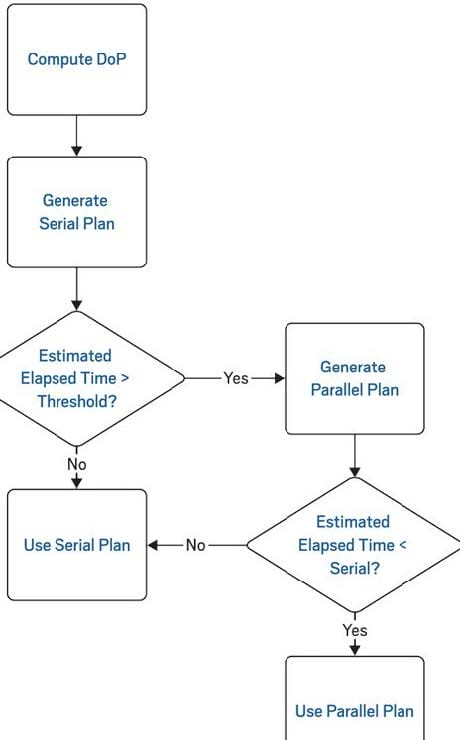1Z0-117 Online Practice Questions and Answers
You are administering a database supporting an OLTP workload. A new module was added to one of the applications recently in which you notice that the SQL statements are highly resource intensive in terms of CPU, I/O and temporary space. You created a SQL Tuning Set (STS) containing all resource-intensive SQL statements. You want to analyze the entire workload captured in the STS. You plan to run the STS through the SQL Advisor.
Which two recommendations can you get?
A. Combing similar indexes into a single index
B. Implementing SQL profiles for the statements
C. Syntactic and semantic restructuring of SQL statements
D. Dropping unused or invalid index.
E. Creating invisible indexes for the workload
F. Creating composite indexes for the workload
You are logged in as the HR user and you execute the following procedure:
SQL > exec DBMS_STATS.SET_TABLE_PREFS (`HR', `EMPLOYEES', `PUBLISH', `FALSE'); SQL> exec DBMS_STATS.GATHER_TABLE_STATS (`HR', `EMPLOYEES');
Which statement is true about the newly gathered statistics?
A. They are temporary and purged when the session exits.
B. They are used by the optimizer for all sessions.
C. They are locked and cannot be overwritten.
D. They are marked as pending and stored in the pending statistics table.
A database supports three applications: CRM, ERP, and ACC. These applications connect to the database by using three different services: CRM_SRV for the
CRM application, ERP_SRV for the ERP application, and ACC_SRV for the ACC application.
You enable tracing for the ACC_SRV service by issuing the following command:
SQL> EXECUTE DBMS for the ACC_SRV service by issuing the following command:
SQL> EXECUITIVE DBMS_MONITOR. SERV_MOD_ACT_TRACE_ENABLE
(service_name => `ACC_SRV', waits => TRUE, binds = > FALSE, instance_name = > `inst1');
Which statement is true?
A. All trace information for the service connection to inst1 will be stored in a single trace file.
B. A trace file is not created because the module name is not specified.
C. A single trace file is created for each session that uses the ACC_SRV service.
D. Only those SQL statements that are identified with the ACC_SRV service executed on the inst1 instance are recorded in trace files.
E. All trace information for the ACC_SRV service connected to inst1 is stored in multiple trace files, which can be consolidated by using the tkprof utility.
An application user complains about statement execution taking longer than usual. You find that the query uses a bind variable in the WHERE clause as follows:

You want to view the execution plan of the query that takes into account the value in the bind variable PCAT. Which two methods can you use to view the required execution plan?
A. Use the DBMS_XPLAN.DISPLAY function to view the execution plan.
B. Identify the SQL_ID for the statementsand use DBMS_XPLAN.DISPLAY_CURSOR for that SQL_ID to view the execution plan.
C. Identify the SQL_ID for the statement and fetch the execution plan PLAN_TABLE.
D. View the execution plan for the statement from V$SQL_PLAN.
E. Execute the statement with different bind values and set AUTOTRACE enabled for session.
Examine the Exhibit and view the structure of an indexes for the EMPLOYEES table.
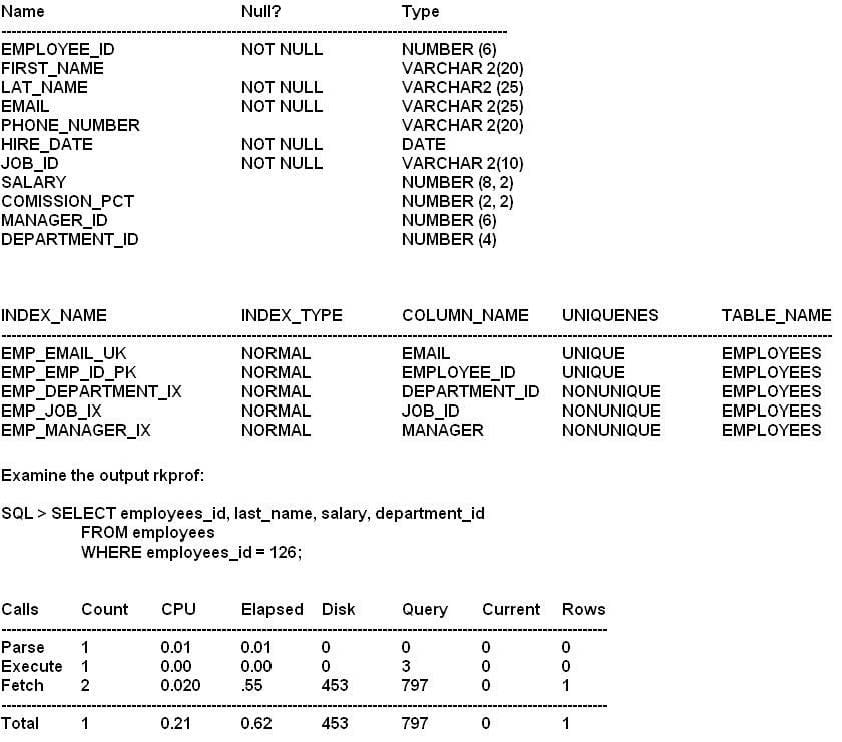
Which two actions might improve the performance of the query?
A. Use the ALL_ROWS hint in the query.
B. Collect the histogram statistics for the EMPLOYEE_ID column.
C. Decrease the value for the DB_FILE_MULTIBLOCK_READ_COUNT initialization parameter.
D. Decrease the index on the EMPLOYEE_ID if not being used.
E. Set the OPTIMIZER_MODE parameter to ALL_ROWS.
View the exhibit and examine the findings provided by the SQL Tuning Advisor for SELECT Statement.
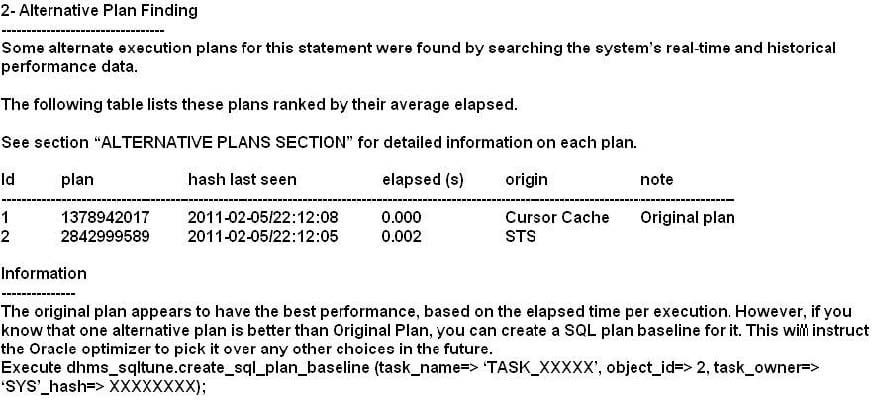
A SWL plan baseline already exists for the execution plan.
What two methods can you use to ensure that an alternate plan becomes an accepted plan?
A. Use the DBMS_SPM.ALTER_SQL_PLAN_BASELINE function.
B. Use the DBMS_SQLTUNE.CREATE_SQL_PLAN_BASELINE function.
C. Use the DBMS_SQLTUNE.CREATE_SQL_PLAN_BASELINE function and run the DBMS_STATS to manually refresh stale statistics.
D. Use the DBMS_SPM.LOAD_PLANS_FROM_SQLSET function.
You ran a high load SQL statement that used an index through the SQL Tuning Advisor and accepted its recommendation for SQL profile creation. Subsequently you noticed that there has been a 2% growth in number of rows in the tables used by the SQL statement and database statistics have also been refreshed. How does this impact the created SQL profile?
A. It becomes invalid and no longer used the optimizer.
B. It remains valid and ensures that the optimizer always use the execution plan that was created before the changes happened.
C. It remains and allows the optimizer to pick a different plan required.
D. It becomes invalid and a new SQL profile is created for the statement by the auto tuning task.
See the table below:
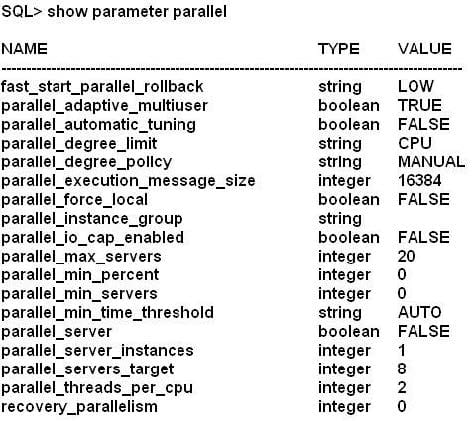
All execution servers are currently available and the sessions use defaults for all parallel settings.
In which two cases will statements execute in parallel?
A. When parallel hints are used but only if estimated serial execution takes more than 10 seconds.
B. When parallelism is defined at the statement level.
C. When the degree of parallelism is explicitly defined in the data dictionary for tables and indexes accessed by a query.
D. Parallel DDL statements but only if estimated serial DDL execution time is greater than 10 seconds.
E. When the degree of parallelism is explicitly defined for tables and indexes but only if estimated serial execution takes more than 10 seconds.
In which three situations must you collect optimizer statistics manually for database objects in addition to automatic statistics collection?
A. When substantial DML activity occurs between the nightly automatic stats gathering maintenance job
B. When substantial activity occurs on a partition of the partitioned table.
C. When a table is used for bulk loads that add 10% or more to the total size of the table
D. When an index is created or dropped for a column
E. When the degree of parallelism is explicitly defined for a table
You are administering a database that supports an OLTP workload. Automatic optimizer statistics collection is scheduled in the night maintenance window. Some of the tables get updated frequently during day time and you notice a performance degradation for queries using those tables due to stale statistics.
Which two options might help to avoid the performance degradation of the queries?
A. Set the global statistics preference STALE_PERCENT to 0.
B. Use dynamically sampling hint for the queries on frequently updated tables.
C. Create histogram for the columns used frequently in the WHERE clause.
D. Gather statistics with global statistics preference NO_VALIDATE to TRUE.
E. Set the OPTIMZER_USE_PENDING_STATISTICS parameter to TRUE.
You are administering a database that supports a DSS workload, where in an application a set of queries use the query rewrite on materialized views. You notice that these queries are performing poorly.
Which two actions can you make to improve the performance of theses queries?
A. Use DBMS_MVIEW.EXPLAIN_REWRITE to analyze whether the queries are rewritten.
B. USE DBMS_ADVISOR.QUICK_TUNE to analyze the query rewrite usage of materialized views for the entire workload.
C. Create an STS for all the queries and use SQL performance Analyzer to generate recommendations for determining the regressed SQL statements.
D. Create an STS for all the queries in the application and use the SQL Tuning Advisor to generate recommendations.
E. Create an STS for all the queries in the application and use the SQL Access Advisor to generate a recommendation for optimizing materialized views for maximum query rewrite usage and fast refresh.
Examine the Exhibit to view the structure of and indexes for the EMPLOYEES and DEPARTMENTS tables:
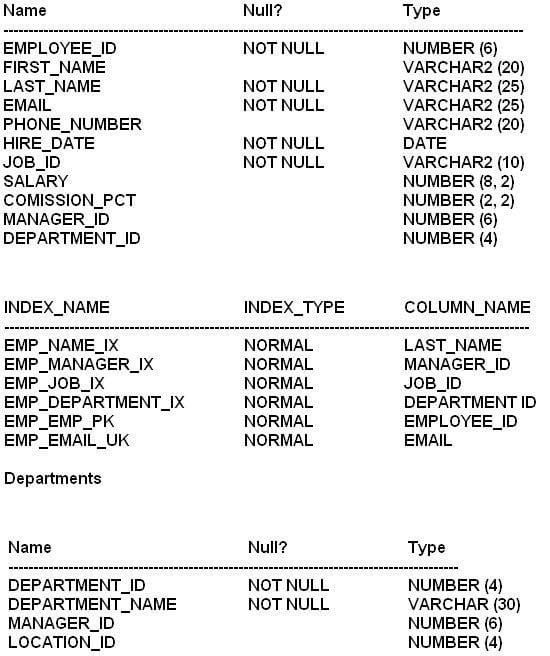
EXAMINE the SQL statement and its execution plan:
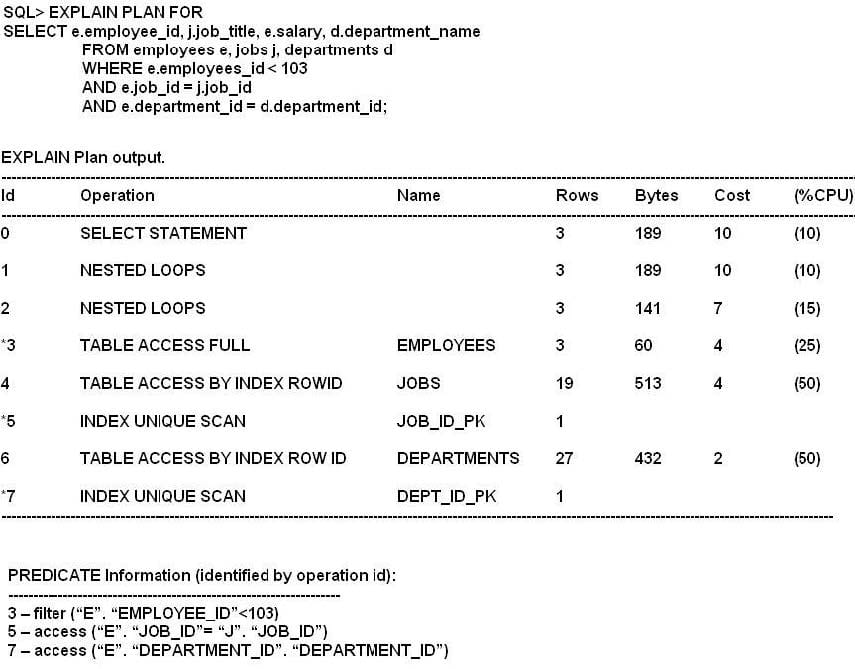

Which two statements are correct regarding the execution plan?
A. Step 2 is performing nested operation on JOB_ID column of the JOBS table, which is the driven table and the EMPLOYEES table is the driven table.
B. In step 2 for every row returned by the JOBS table matching rows from the EMPLOYEES table are accessed.
C. Step 1 is performing nested loop operation on the DEPARTMENT_ID column of the DEPARTMENTS table, which is the driven table and results returned by step 2 in the driving resultset.
D. The performance of the query can be improved by creating bitmap index on the JOB_ID column of the EMPLOYEES table.
E. The performance of the query can be improved by creating bitmapped index on the DEPARTMENT_ID column of the EMPLOYEES table.
Which two statements are true about the use of the DYNAMIC_SAMPLING hint in a query?
A. It estimates selectivity better for the filters.
B. It is always used for flashback queries that contain the AS OF clause.
C. It cannot be used if there is a single-table predicate in the WHERE clause.
D. It cannot be used for processing SQL statements in parallel.
E. It can compensate for the lack of extended statistics to get accurate cardinality estimates for complex predicate expressions.
Examine the parallelism parameters for your instance:
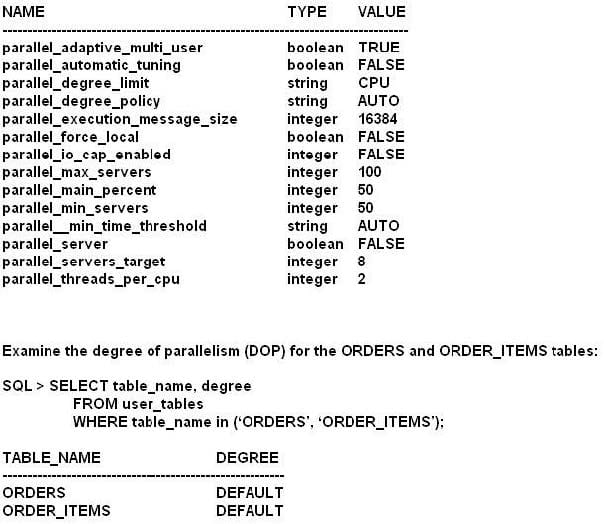
Examine the Exhibit to view the query and its explain plan output.
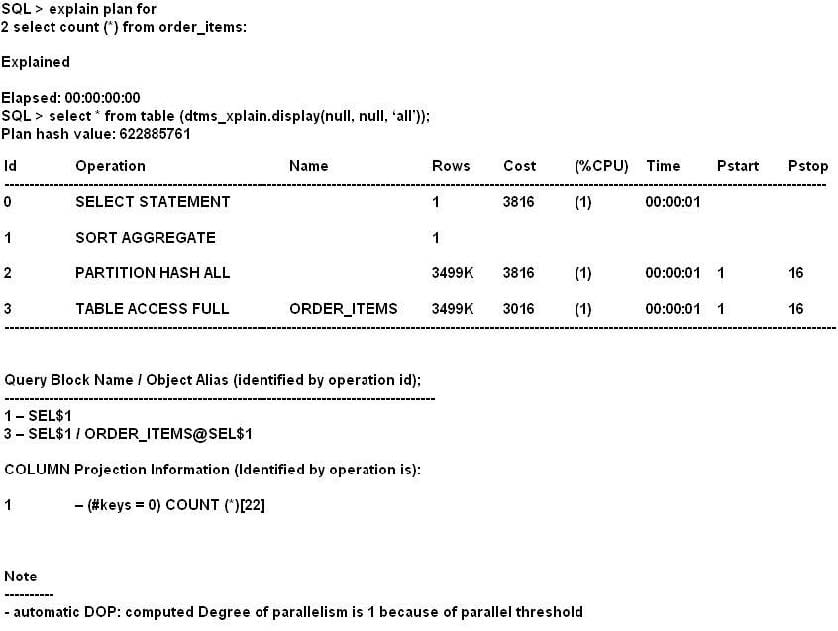
All sessions use default parallelism settings.
What two steps could you take to make the query execute in parallel?
A. Add a parallel hint.
B. Decrease the value of PARALLEL_MIN_TIMETHRESHOLD.
C. Increase the value of PARALLEL_MIN_SERVERS.
D. Increase the value of PARALLEL_MAX_SERVERS.
E. Decrease the value of PARALLEL_MIN_PERCENT.
Examine the Exhibit.
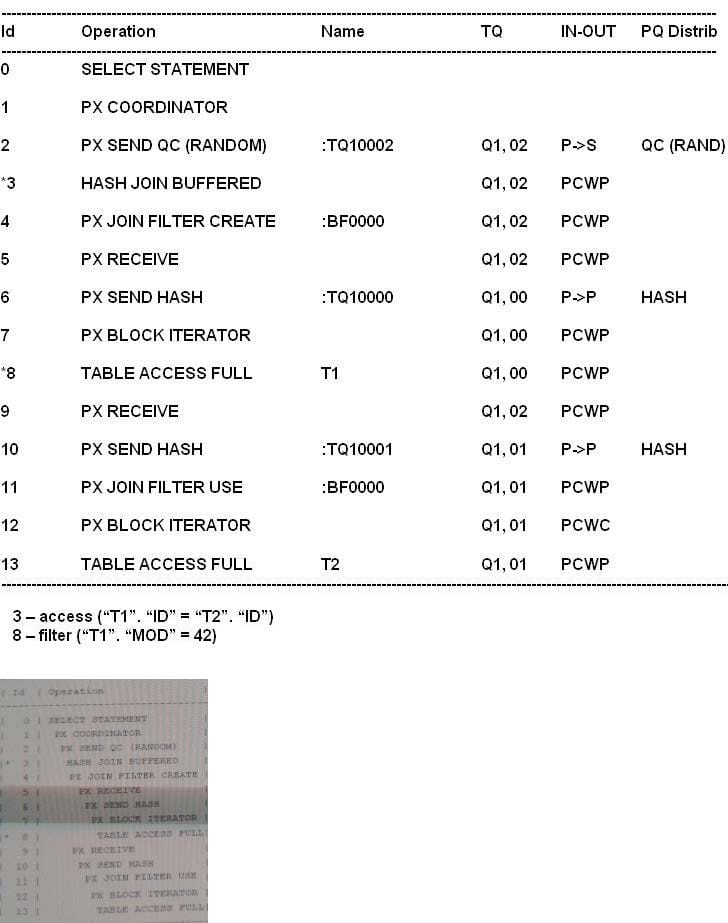
Which two statements are true about the bloom filter in the execution plan?
A. The bloom filter prevents all rows from table T1 that do not join T2 from being needlessly distributed.
B. The bloom filter prevents all rows from table T2 that do not join table T1 from being needlessly distributed.
C. The bloom filter prevents some rows from table T2 that do not join table T1 from being needlessly distributed.
D. The bloom filter is created in parallel by the set of parallel execution processes that scanned table T2.
E. The bloom filter is created in parallel by the set of parallel execution processes that later perform join.
F. The bloom filter is created in parallel by the set of parallel execution processes that scanned table T1.

